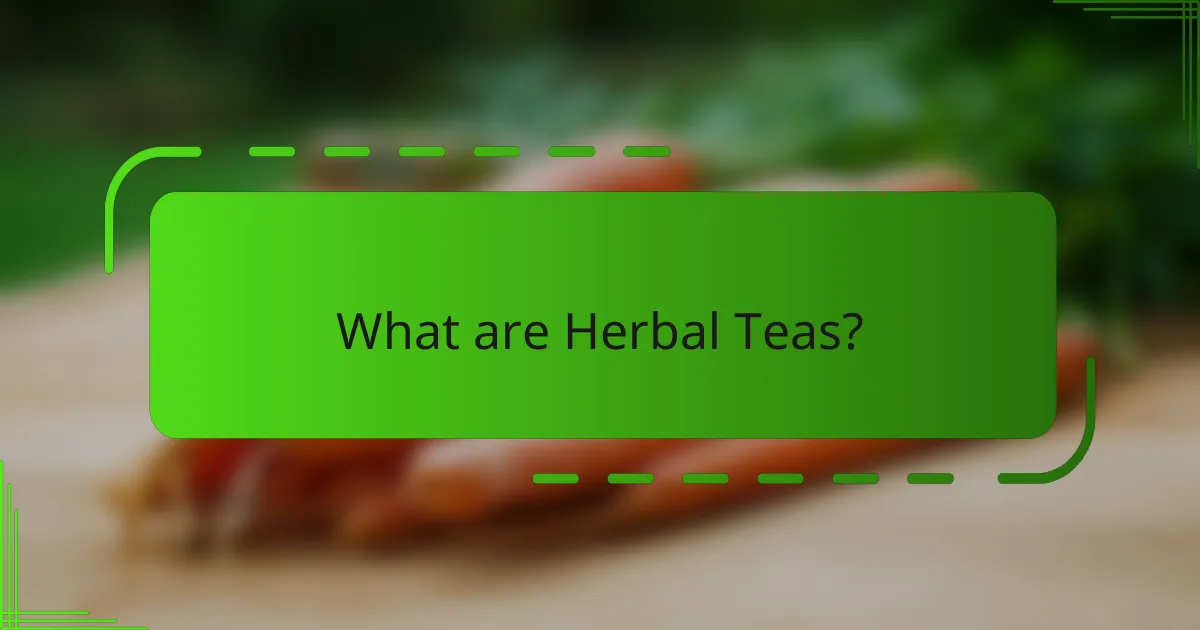Herbal teas are caffeine-free infusions made from various herbs, flowers, fruits, or spices, distinct from traditional teas that use Camellia sinensis leaves. This article explores the health benefits associated with popular varieties of herbal teas, including chamomile, peppermint, hibiscus, and rooibos, highlighting their unique flavors and potential medicinal properties. It also provides detailed brewing techniques to ensure optimal flavor extraction, emphasizing the importance of high-quality ingredients and proper steeping methods. Readers will gain insights into how herbal teas can aid digestion, reduce stress, and improve sleep quality, making them a favored choice among health-conscious consumers.

What are Herbal Teas?
Herbal teas are infusions made from herbs, flowers, fruits, or spices. Unlike traditional teas, they do not contain Camellia sinensis leaves. Herbal teas are often caffeine-free and can offer various flavors and health benefits. Common ingredients include chamomile, peppermint, and hibiscus. Herbal teas have been used for centuries in various cultures for their medicinal properties. Studies indicate that certain herbal teas may aid digestion, reduce stress, and improve sleep quality. The versatility of herbal teas makes them popular among health-conscious consumers.
How are Herbal Teas different from traditional teas?
Herbal teas differ from traditional teas primarily in their ingredients. Traditional teas are made from the leaves of the Camellia sinensis plant. This includes varieties like black, green, and oolong tea. Herbal teas, on the other hand, are infusions made from a variety of herbs, flowers, fruits, and spices. They do not contain tea leaves from the Camellia sinensis plant.
Additionally, traditional teas typically contain caffeine, while most herbal teas are naturally caffeine-free. Herbal teas are often consumed for their specific health benefits, which can vary widely based on the ingredients used. For example, chamomile is known for its calming effects, while peppermint may aid digestion.
The preparation methods can also differ. Traditional teas usually require specific steeping times and temperatures to extract optimal flavors and benefits. Herbal teas can often be steeped for longer periods and at varying temperatures, depending on the herbs used.
What ingredients are commonly used in Herbal Teas?
Common ingredients used in herbal teas include chamomile, peppermint, hibiscus, and ginger. Chamomile is known for its calming effects and is often used to promote sleep. Peppermint provides a refreshing flavor and aids digestion. Hibiscus is rich in antioxidants and can help lower blood pressure. Ginger adds a spicy kick and is recognized for its anti-inflammatory properties. Other ingredients may include lemongrass, rooibos, and various fruits and flowers, each contributing unique flavors and health benefits.
How do Herbal Teas derive their flavors and benefits?
Herbal teas derive their flavors and benefits from the specific plants used in their preparation. The leaves, flowers, seeds, and roots of various herbs contain essential oils, flavonoids, and other compounds. These compounds contribute to the unique taste profiles of each herbal tea. For example, chamomile has a sweet, apple-like flavor due to its chamazulene content.
The health benefits of herbal teas come from these same compounds. Antioxidants found in hibiscus tea can lower blood pressure. Similarly, the anti-inflammatory properties of ginger can aid digestion. The brewing process also influences flavor and potency. Steeping time and water temperature can enhance or diminish the extraction of beneficial compounds.
Research shows that proper brewing techniques maximize the release of flavors and health benefits. For instance, a study published in the Journal of Food Science found that steeping herbal teas at higher temperatures increases the extraction of polyphenols. Thus, the flavors and benefits of herbal teas are intricately linked to their botanical sources and preparation methods.
What are the health benefits of Herbal Teas?
Herbal teas offer various health benefits, including improved digestion, enhanced relaxation, and antioxidant properties. They can aid in digestion by soothing the stomach and reducing bloating. Ingredients like peppermint and ginger are known for their digestive support. Herbal teas promote relaxation and reduce stress through calming herbs like chamomile and lavender. These herbs help lower anxiety levels and improve sleep quality. Additionally, herbal teas contain antioxidants that combat oxidative stress and support overall health. Some studies indicate that hibiscus tea may lower blood pressure, while rooibos tea has anti-inflammatory properties. These benefits make herbal teas a popular choice for health-conscious individuals.
Which Herbal Teas are known for their calming effects?
Chamomile tea, lavender tea, and lemon balm tea are known for their calming effects. Chamomile contains apigenin, which binds to receptors in the brain to promote relaxation. Lavender tea has been shown to reduce anxiety and improve sleep quality. Lemon balm tea is associated with reduced stress and enhanced mood. Studies support these claims, demonstrating their efficacy in promoting calmness and reducing tension. For example, a study published in the Journal of Clinical Psychopharmacology found that lavender oil significantly reduced anxiety levels.
How can Herbal Teas support digestion and gut health?
Herbal teas can support digestion and gut health through various mechanisms. Many herbal teas contain compounds that promote digestive enzyme activity. For example, peppermint tea can relax the digestive tract muscles, reducing bloating and discomfort. Ginger tea is known for its anti-inflammatory properties, which can soothe the stomach lining. Chamomile tea may help reduce gastrointestinal inflammation and promote overall gut health. Studies have shown that certain herbal teas can increase gut microbiota diversity, which is essential for optimal digestion. Additionally, the warm nature of herbal teas can aid in the breakdown of food, enhancing nutrient absorption.
What role do Herbal Teas play in boosting immunity?
Herbal teas play a significant role in boosting immunity. They contain various antioxidants, vitamins, and minerals that support the immune system. For instance, echinacea tea is known for its ability to enhance immune function. Studies indicate that it can reduce the duration of colds. Similarly, ginger tea has anti-inflammatory properties that may help in fighting infections. Research shows that ginger can increase the production of immune cells. Additionally, chamomile tea has been linked to improved immune response due to its antioxidant content. Overall, herbal teas provide essential compounds that contribute to a stronger immune system.

What are the popular varieties of Herbal Teas?
Popular varieties of herbal teas include chamomile, peppermint, hibiscus, and rooibos. Chamomile tea is known for its calming effects and is often used to aid sleep. Peppermint tea is refreshing and can help with digestion. Hibiscus tea has a tart flavor and is rich in antioxidants. Rooibos tea is caffeine-free and contains various minerals. Other notable varieties include lemon balm, ginger, and echinacea. Each variety offers unique flavors and potential health benefits.
Which Herbal Teas are most commonly consumed?
Chamomile, peppermint, and hibiscus are among the most commonly consumed herbal teas. Chamomile is known for its calming effects and is often used to aid sleep. Peppermint tea is popular for its digestive benefits and refreshing flavor. Hibiscus tea is favored for its tart taste and potential heart health advantages. These teas are widely consumed globally, with chamomile leading in popularity in many regions. According to a survey by the Tea Association of the USA, herbal teas account for approximately 35% of all tea consumed in the U.S., highlighting their prevalence.
What are the unique attributes of Chamomile Tea?
Chamomile tea has several unique attributes. It is known for its calming properties, often used to promote relaxation and sleep. Chamomile contains antioxidants, specifically apigenin, which may help reduce anxiety. The tea has anti-inflammatory effects, aiding in digestive health. Its unique floral aroma differentiates it from other herbal teas. Chamomile tea is caffeine-free, making it suitable for all ages. Additionally, it is often used as a natural remedy for menstrual pain. Each of these attributes contributes to its popularity and effectiveness as a herbal tea.
How does Peppermint Tea differ from other Herbal Teas?
Peppermint tea differs from other herbal teas primarily due to its unique flavor profile and active compounds. It is made from the leaves of the peppermint plant, which contains menthol, giving it a distinct cooling taste. This menthol content also contributes to its digestive benefits, making it effective for soothing upset stomachs.
In contrast, other herbal teas, such as chamomile or rooibos, have different flavor profiles and health benefits. Chamomile is known for its calming effects, while rooibos is caffeine-free and rich in antioxidants. Additionally, peppermint tea is often consumed for its invigorating aroma, which can enhance focus and alertness.
Research supports the digestive benefits of peppermint tea. A study published in the Journal of Gastroenterology found that peppermint oil, a key component of peppermint tea, can alleviate symptoms of irritable bowel syndrome (IBS). This specific benefit sets peppermint tea apart from many other herbal varieties.
What are some lesser-known Herbal Teas worth exploring?
Some lesser-known herbal teas worth exploring include rooibos, honeybush, and lemon verbena. Rooibos, originating from South Africa, is caffeine-free and rich in antioxidants. Honeybush, also from South Africa, has a naturally sweet flavor and may support respiratory health. Lemon verbena, native to South America, offers a refreshing citrus taste and is known for its calming properties. Each of these teas presents unique benefits and flavors that can enhance your herbal tea experience.
What benefits does Rooibos Tea offer?
Rooibos tea offers several health benefits. It is rich in antioxidants, which help combat oxidative stress. These antioxidants include aspalathin and nothofagin. Rooibos tea may also support heart health by improving cholesterol levels. Research indicates that it can lower bad cholesterol (LDL) and increase good cholesterol (HDL). Additionally, Rooibos tea is caffeine-free, making it suitable for all ages. It may aid digestion and alleviate stomach cramps. Some studies suggest it can improve skin health due to its anti-inflammatory properties. Overall, Rooibos tea is a nutritious beverage with multiple health advantages.
How does Hibiscus Tea contribute to health?
Hibiscus tea contributes to health by providing various benefits. It is known to lower blood pressure. Studies show that hibiscus tea can reduce systolic blood pressure by an average of 7.58 mmHg. This effect is attributed to its high antioxidant content. Hibiscus is rich in anthocyanins, which support cardiovascular health. Additionally, hibiscus tea may aid in weight management. Research indicates it can reduce body weight and body fat. It also has diuretic properties, promoting kidney health. Furthermore, hibiscus tea may help lower cholesterol levels. Clinical trials have demonstrated its ability to reduce LDL cholesterol. Overall, hibiscus tea is a beneficial herbal remedy for various health concerns.

How can you brew Herbal Teas effectively?
To brew herbal teas effectively, start by selecting high-quality loose herbs or tea bags. Use fresh, filtered water for the best flavor extraction. Heat the water to the appropriate temperature, typically between 190°F to 212°F. Measure about one teaspoon of loose herbs or one tea bag per cup of water. Steep the herbs for the recommended time, usually 5 to 15 minutes, depending on the type of herb. Cover the tea while steeping to retain heat and enhance extraction. Strain the tea to remove herbs before serving. Enjoy the tea plain or add sweeteners or citrus for flavor.
What are the basic steps to brew Herbal Teas?
To brew herbal teas, follow these basic steps. Start by selecting your herbal ingredients. Common options include chamomile, peppermint, and hibiscus. Measure about one teaspoon of dried herbs per cup of water. Boil fresh water to the appropriate temperature, usually around 200°F for most herbs. Pour the hot water over the herbs in a teapot or cup. Steep the mixture for 5 to 10 minutes, depending on the desired strength. Strain the herbs using a fine mesh or tea strainer. Finally, enjoy your herbal tea plain or with added sweeteners or lemon, if desired.
What water temperature is ideal for different Herbal Teas?
The ideal water temperature for different herbal teas typically ranges from 190°F to 212°F (88°C to 100°C). Most herbal teas, such as chamomile and peppermint, benefit from boiling water at 212°F. This temperature helps to extract essential oils and flavors effectively. Some delicate herbal blends may require slightly cooler water, around 190°F. Using water that is too cool can result in a weak infusion. Conversely, boiling water can sometimes lead to bitterness in certain herbs. The general guideline is to steep herbal teas for 5 to 10 minutes at these temperatures to achieve the best flavor.
How long should you steep Herbal Teas for optimal flavor?
Herbal teas should be steeped for 5 to 10 minutes for optimal flavor. Steeping for this duration allows the herbal compounds to fully infuse into the water. Different herbs may require slight adjustments within this range. For instance, stronger herbs like peppermint may be best at the lower end, while more delicate herbs like chamomile may benefit from the longer steeping time. This steeping time is widely recommended by tea experts and is supported by brewing guidelines from various tea organizations.
What tips can enhance your Herbal Tea brewing experience?
Use fresh, high-quality herbs to enhance flavor. Fresh herbs contain more essential oils and nutrients. Measure the right amount, typically one teaspoon per cup. This ensures optimal extraction of flavors. Use filtered water to avoid impurities that affect taste. Heat water to the appropriate temperature, usually around 200°F for herbal teas. Steep for the recommended time, generally 5 to 10 minutes. This allows the herbs to release their full flavor and benefits. Cover the teapot while steeping to retain heat and enhance infusion. Experiment with combinations of herbs for unique flavors and benefits.
How can you customize your Herbal Tea blends?
You can customize your herbal tea blends by selecting different herbs, spices, and flavors. Choose a base herb like chamomile or peppermint for your blend. Add complementary herbs such as lemon balm or hibiscus to enhance flavor. Incorporate spices like ginger or cinnamon for warmth and depth. Adjust the proportions to suit your taste preferences. Experiment with dried fruits like apple or berries for sweetness. Consider adding citrus peels for a refreshing twist. Steep your blend for varying durations to achieve desired strength. Personalizing your herbal tea allows for unique flavor profiles tailored to individual preferences.
What common mistakes should you avoid when brewing Herbal Teas?
Common mistakes to avoid when brewing herbal teas include using boiling water, which can scorch delicate herbs. Herbal teas require steeping at lower temperatures, typically between 190°F to 212°F. Another mistake is steeping for too short a time. Most herbal teas benefit from a steeping time of 5 to 15 minutes. Using insufficient herbs is also a common error. A general guideline is to use one teaspoon of dried herbs per cup of water. Not covering the tea while steeping can lead to loss of essential oils and flavors. Lastly, reusing herbs for multiple brews can diminish flavor and potency. Following these guidelines ensures a better herbal tea experience.
Herbal teas are infusions made from various herbs, flowers, fruits, and spices, distinct from traditional teas that use Camellia sinensis leaves. This article covers the health benefits of herbal teas, including their roles in digestion, relaxation, and immune support, while highlighting popular varieties such as chamomile, peppermint, and hibiscus. It also provides effective brewing techniques to maximize flavor and benefits, and discusses unique attributes of specific herbal teas. Overall, the content aims to inform readers about the versatility and advantages of incorporating herbal teas into their wellness routines.